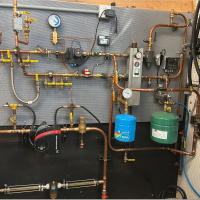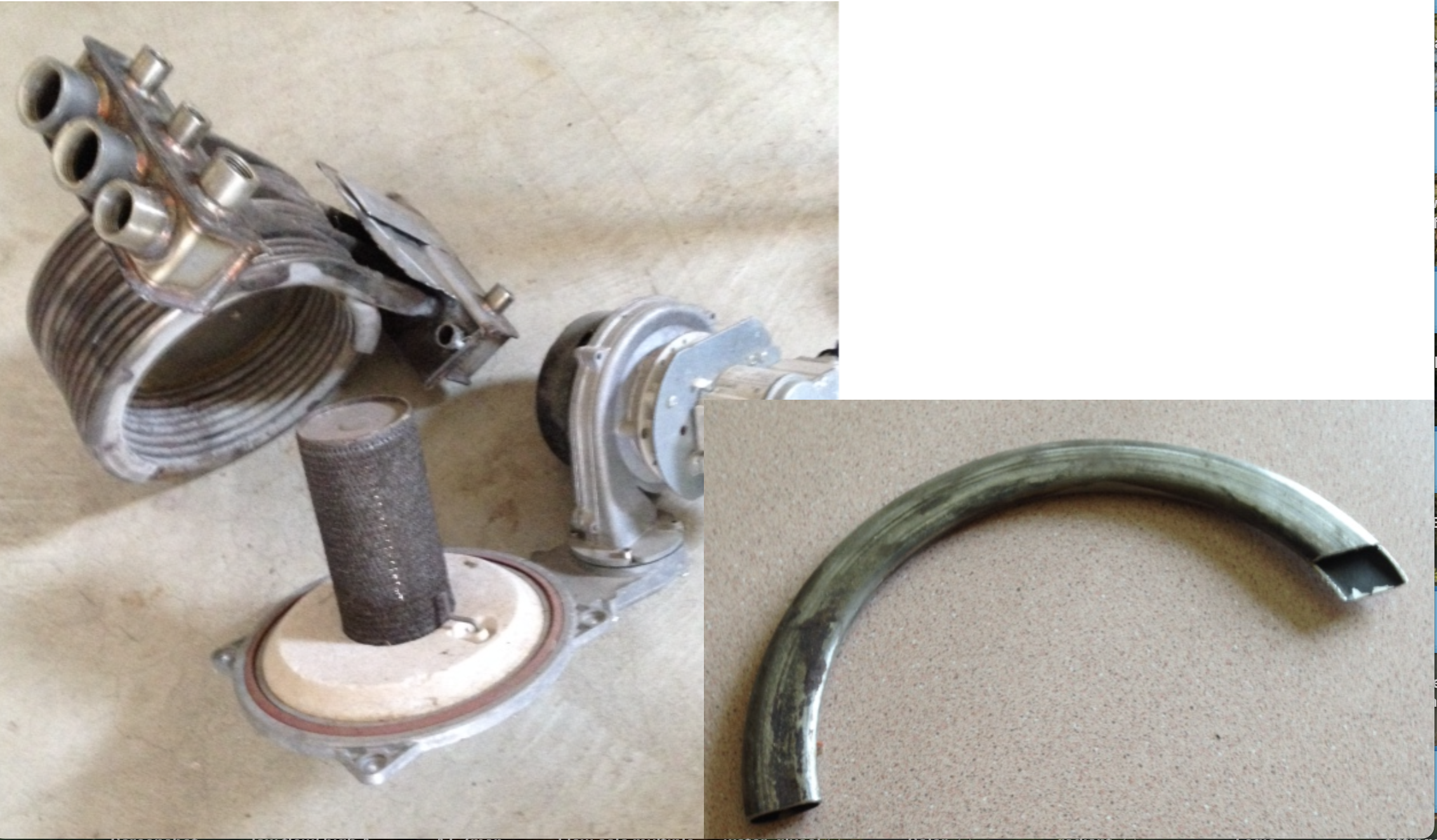Mod Con broken down to the basics

Strip away all the case, electronics, wiring and you get to the intersection of fire and water. Gas and air blend in the burner mounting passage, which is also the mounting plate for the fan and gas valve, very simple engineering. A spark starts the fire.
Properly installed and cared for this is a very durable, reliable and efficient HX design. I think easier to service compared to fire tubes, much less welding exposed to direct flame also.
This was a Knight I installed in my home many years ago. About a year into it it started throwing random low flow lock outs. I could never duplicate the issue when sitting in front of it. Checked all the typical flow obstruction issues, nothing.
Finally ripped it out, destined to be a parts boiler as I had many of this model installed for customers. I started sawing into the HX tubes on a quest for the blockage. Oddly I left that ell and nipple on the HX to clamp it into the vice, so I missed the hidden check before I started cutting.
The boiler circ was one of the early Grundfos ICFs. The first ones had a small diameter check which was not held in very well with the o-ring and plastic tabs on the side.
When I disassembled it the check had puked out of the circ and stuck in a 1" ell right at the boiler connection. It would turn to different positions in the ell, so flow would sometimes be fine.
I had filled it with good water and added Rhomar conditioner from day one.
The black you see on the tube I cut open is the film provider in the Rhomar. It looked lik a magic marker coating inside the tubes, very thin layer of color. This protects the stainless from aggressive fluids, low ph, or high chlorides in fill water without much if any heat transfer penalty.
I've been sold on boiler conditioners ever since.
trainer for Caleffi NA
Living the hydronic dream
Comments
-
I've never been crazy about the plastic flow checks...did any manufacturer try a brass type? Mad Dog
0 -
I have not seen any of the circulator IFCs made out of brass or any metal.
The solar pump stations have brass on brass seat checks, but they are in the isolation valve against the pump. A better location actually out of the more turbulent conditions the volute.
I think Apollo/ Conbraco still make brass hydronic checks, maybe a rubber seat with a brass disc.
Are most of the small circs built with plastic impellers? Possibly the same material as the checks?
Bob "hot rod" Rohr
trainer for Caleffi NA
Living the hydronic dream0 -
-
-
Had an internal flow check come out of a pump on a viessmann 399 one time. The HX design splits the supply and return into 2 separate S/R at the HX, high quality flow sensors on the outlet that watch for a minimum flow rate, as well as the differential between the two, if it gets too high it shuts down assuming there is a blockage in the HX. after many stressful days I finally gave the go ahead to pull the boiler and wouldn't you know it a little check valve was right there
0 -
-
-
Oftentimes, IFC's are not shown on the parts diagram. This was the case with a Viessmann 222 where I spent days looking for the blockage and only found it by accident. It was also a surprise revelation to the Viessmann tech. support guys.
When flow stops in a system, there are the usual culprits: air in the system, bad pump and the occasional obstruction. The first two are easier to figure out than the last one and the last one can be many things.
We need a more reliable IFC. Plastic components with a fragile spring just doesn't cut it.
It should also be made easier to inspect. Have you ever tried to remove an IFC from a Grundfos volute?
8.33 lbs./gal. x 60 min./hr. x 20°ΔT = 10,000 BTU's/hour
Two btu per sq ft for degree difference for a slab2 -
-
The tabs on the sides of those Neoperl checks do a great job of holding them in. As long as there is a groove or something for them to engage to.
With a fine tolerance check, such as the ICF, a strainer is almost a must.
Checks in 3 way and 4 way thermostatic valves always include screens. BUT, they need to be maintained, just like a Y strainer.
The checks and screens in the under sink H style thermostatic are tiny.
When checks are new and lubed they slide in and out easily. Probably a week after use, not so easily :)
Springs have an expected service life like anything else. The systems with any air in them really cause the springs to get over-worked. The checks and springs chatter like geese eating dominos.
Even un-reamed copper tube will create bubbles problematic for small low psi checks
Bob "hot rod" Rohr
trainer for Caleffi NA
Living the hydronic dream1 -
I'm considering installing one of those to solve my now i have the indirect set hotter and need to mix in some cold to wash my hands but it is a 2 handle faucet and that is significantly more incontinent all day long than just turning on one handle problem. Also I don't think the american standard 2 handle cartridges are as heat resistant as they used to be after they switched from the beige to the black plastic.
0 -
-
i know with the neoperl checks, the HT series, high temperature, are all black?
Bob "hot rod" Rohr
trainer for Caleffi NA
Living the hydronic dream0 -
I mean the cartridges for the faucet. The ones that came with it 25 years ago and the first replacements would last for like a decade until the seals around the ceramic disc would leak, the ones I have got in the past 5 years or so last a year or 2 when the plastic that connects the disc to the stem cracks.
0 -
Composites, plastics, etc, whatever the use, plbg or hgt, when they are black it usually indicates carbon black has been added to the blend. This makes the material more thermally stable.
So the engineers tell me.
Bob "hot rod" Rohr
trainer for Caleffi NA
Living the hydronic dream0 -
what are plbg and hgt? google was useless
0 -
-
oh, i read that wrong, i thought those were types of plastic…
0
Categories
- All Categories
- 87.3K THE MAIN WALL
- 3.2K A-C, Heat Pumps & Refrigeration
- 61 Biomass
- 429 Carbon Monoxide Awareness
- 120 Chimneys & Flues
- 2.1K Domestic Hot Water
- 5.8K Gas Heating
- 115 Geothermal
- 167 Indoor-Air Quality
- 3.7K Oil Heating
- 77 Pipe Deterioration
- 1K Plumbing
- 6.5K Radiant Heating
- 395 Solar
- 15.7K Strictly Steam
- 3.4K Thermostats and Controls
- 56 Water Quality
- 51 Industry Classes
- 50 Job Opportunities
- 18 Recall Announcements









